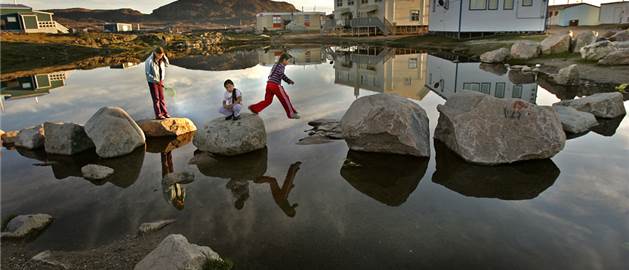
 “Circus Without Borders,” explores two circus troupes, one, Artcirq, with its basis in the traditions and history of the indigenous people of the Inuit island of Igloolik. The second, Kalabante, a talented group of Guinea natives who turned a remarkable gift of both affinity and strength in traditional acrobatics into an impressive act of phenomenal feats of strength, grace and music.
“Circus Without Borders,” explores two circus troupes, one, Artcirq, with its basis in the traditions and history of the indigenous people of the Inuit island of Igloolik. The second, Kalabante, a talented group of Guinea natives who turned a remarkable gift of both affinity and strength in traditional acrobatics into an impressive act of phenomenal feats of strength, grace and music.
“Circus Without Borders” does not inherently focus on the link between the two groups, as one might infer from the title. In fact, it only briefly touches upon the meeting of the two groups. Rather, the film gives an in depth view of the individual groups overall, which integrates stunning visual displays and spectacular performances with a very human and personal examination of their raison d’être, so to speak.
Artcirq, founded by Guillaume Saladin, was created with the intention to both reclaim the lost traditions of the Inuit in a way that they might be preserved and shared with the world and to prevent suicide among Igloolik youth, who are at disproportionately high risk.
Kalabante, meanwhile, began with the recruitment of natives of Guinea, such as the immensely talented Yamoussa Bangoura, leader of Kalabante; by Quebec-based circus company Cavalia and various others, which culminated in a formation of an independent and elite troupe of acrobats, who incorporate their culture into captivating musical and acrobatic displays.
Circus Without Borders Trailer from Northern Light Productions on Vimeo.
The two groups do in fact meet in the film, however the encounter, though close and friendly, is quite brief and incidental.
One needn’t have an interest in circuses or anthropology to enjoy the film. The natural drama creates a very compelling narrative and constant changes in location, scenery and environment are enough to keep any viewer visually engaged and drawn into the film.
*One audience member asked why there were not more female performers, as she presumably felt that variety of genitalia played an important role in this film. To which the director replied, “Because Guinea is sexist.†To evidence which she cited the fact that women in Guinea are expected to cook and clean before anything else. Presumably, this was already thought out in a broader anthropological context, rather than simply an ethnocentric jab at a culture where problems are not so much broken iPhones and poor dietary habits, but cracked roofs allow water in when it rains and widespread hunger (Spoiler alert: as evidenced by one child in the film shown in Guinea, attempting to escape the rain and very noticeably suffering from kwashiorkor); a somewhat un-American problem.
Feminist issues aside, the film showed two very colorful and distinctive cultures with unique and interesting traditions, each carefully woven into a tapestry of eye-catching feats of endurance and raw talent.
There are some very touching moments outlining personal and interpersonal sentiment and hardship and all in all, the film goes beyond the outward displays of the performers and focuses on a less displayed, more inward and ethereal aspect.
If this film does not impress with its craftsmanship and overall composition, seamless editing or exploration of the hearts and minds of those within it; it might at least inspire one to take up a career as an acrobat or performer through the apparent skill and mettle of the talented acts and stunts of the performers of Kalabante and Artcirq.

Leave a Reply